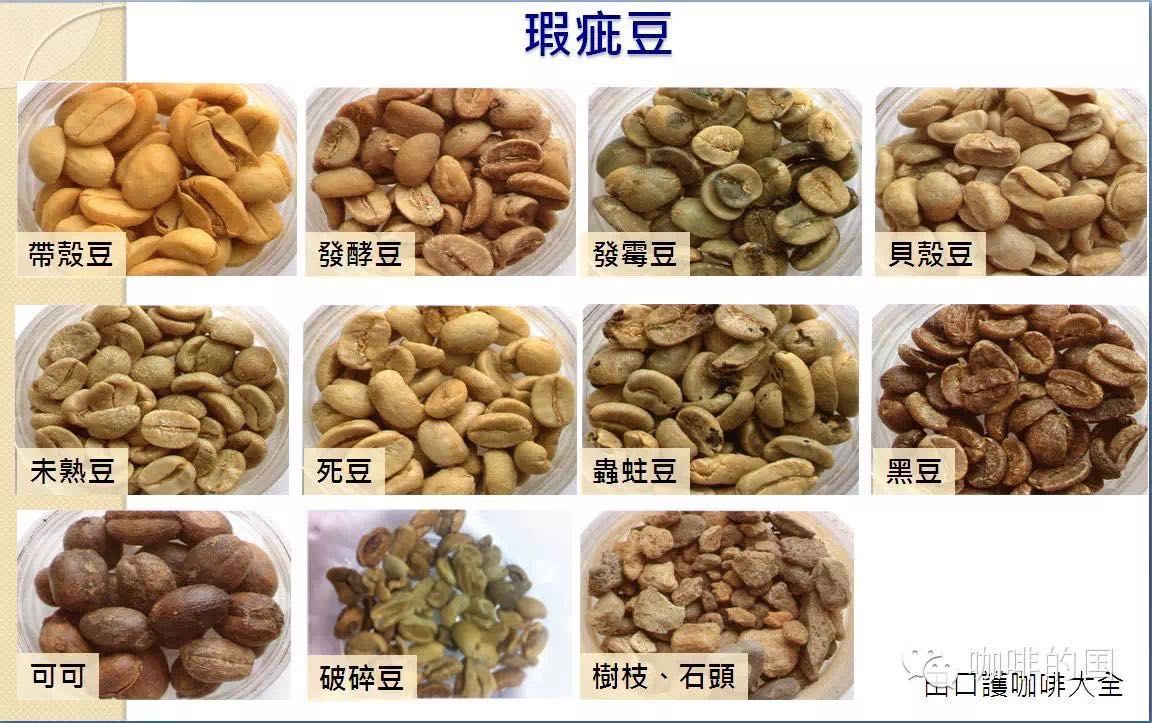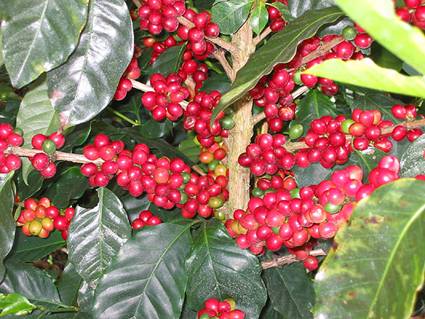Introduction of coffee defective bean varieties to understand the culprit that affects the quality of a cup of coffee
Coffee beans have a lot of flaws, and the flaws are varied. There are many reasons for defects, and defects may affect our taste experience of coffee on different levels, and may also affect health. However, many defects that are obvious in raw beans can quickly disappear once baked. Therefore, we usually see coffee cooked beans, mostly uniform appearance, consistent appearance, showing Huahua Lili coffee color, and in milk, as well as a variety of flavor syrup modification, its true color flavor is largely hidden!

Coffee, after all, as a crop, needs to go through a long and arduous series of processes from sowing, planting, harvesting, processing, storage, roasting, preservation, and production before reaching our cups and adding color to life. This is so not easy! The appearance of large and small flaws is very normal, just a matter of how many. The beans that want to become fine coffee need to go through many obstacles. Each link needs to be carefully handled and taken seriously. Let's take a look at SCAA's (Specialty Coffee Association of America) classification requirements for Arabica specialty coffee.
[Defect breakdown type](350g raw beans)
According to SCAA Arabica grading standards (see table above), green coffee bean defect types are classified into Class I defects and Class II defects according to the degree of impact on coffee quality. The two defect types have different subdivision defect items, and each defect bean has a corresponding number of defects recorded as 1 unit defect. Therefore, after calculating the number of each defect, it should be converted into the number of unit defects (full defect). For example, 1 full black bean in a class of defects is recorded as a class of defects in one unit;5 serious moth-eaten beans are also recorded as a class of defects in one unit. (Less than 5 are not counted, 6 are still counted as a Class 1 defect of a unit). Three partially black beans were counted as a Class II defect; ten slightly moth-eaten beans were counted as a Class II defect.
Fine coffee requirements meet:
◆ Even 1 unit of Class I defect is not allowed in 350g raw bean sample, while Class II defect cannot exceed 5 units.
◆ In the 100g cooked bean sample, no quaker beans are required.
[Water content]
Wash beans: 10%~12%
Sun-dried beans: 10%~13%
[Raw Bean Scent]
No strange smell.
[Raw Bean Size]
size indicated in the contract, the variance is less than 5%.
★ Note: If multiple defects are found in a coffee bean at the same time, the type of defect that has the greatest impact on the quality of the coffee cup will be selected for scoring.
The following is a detailed introduction to all kinds of defective beans.
[Whole Black Bean/Partial Black Bean]
Description: Raw beans with completely black internal or external surfaces, opaque black.
Cause: excessive fermentation caused by organic microorganisms.
Cup test performance: fermentation or stinky, dirty, acid, musty, phenolic flavor.
[Whole sour beans/partial sour beans]
Description: Fermented green beans with a light yellow or reddish brown color throughout.
Cause: Fermentation caused by microbial infection during harvesting and handling. This may be due to: ripe coffee cherries harvested or dropped on the ground; water contamination during processing; or excessive fermentation of coffee cherries hanging from trees in a wet state.
Cup test performance: according to the different degrees of fermentation, may appear smelly, acid, fermentation flavor.
Mold infection]
Description: Raw beans with yellow or reddish brown color due to mildew.
Cause: The temperature and humidity during harvest and storage are suitable for mold growth.
Cup test performance: may produce fermentation, mildew, dirty taste, phenol taste.
[Foreign Substance]
Description: Stone or tree branches and other foreign matter other than coffee.
Cause: May occur at any green bean processing stage.
Cup test performance: let coffee taste bad.
[Dried Coffee Cherry/Pod]
Description: Green beans partially or completely wrapped in black rind.
Cause: incomplete treatment of washed beans in the process of removing pulp or incomplete treatment of floating substances in the initial water; incomplete treatment of sun-dried beans in shelling or sorting.
Cup test performance: fermentation, mildew, phenol flavor.
[Severely/Slightly Worm-eaten Beans]
Description: Less than 3 (slightly moth-eaten beans) or more than 3 (severely moth-eaten beans) with a diameter of 0.3~1.5mm are gnawed by insects.
Cause: Mainly affected by berry borer beetle.
Cup test performance: affect the appearance of ripe beans, may bring dirty taste, Rio taste, or musty taste.
[Broken Bean]
Description: Broken green beans or green bean fragments.
Cause: improper adjustment of machine during raw bean processing and pulp removal.
Cup test performance: earthy taste, dirty taste, acid, fermentation.
[Unripe beans]
Description: Silver skin firmly adhere to the surface of raw beans, and beans concave, size small, sharp end, slightly ship-shaped.
Origin: Harvested in immature state.
Cup test performance: grass flavor, straw flavor, green flavor, coffee astringency is the main source.
[Shrunken Bean]
Description: Raisin-like wrinkled, size small, misshapen green beans.
Causes: Insufficient water supply and excessive sunlight during development.
Cup test performance: grass flavor, straw flavor.
[Shell beans]
Description: A deformed raw bean with a thin shell or ear shape.
Cause: genetics.
Cup test performance: burnt smell.
[Floating Bean]
Description: White or faded raw beans float on water because of their lightness.
Cause: improper storage or drying. Shelled beans are left in the corners of dryers or drying racks to form faded, low-density beans. Or shelled beans stored in high humidity.
Cup test performance: fermentation, grass, straw, earthy, musty may occur, but also in the case of coffee flavor dilution.
[Parchment Shell Bean]
Description: Dry parchment paper completely or partially wrapped in raw beans.
Cause: improper machine calibration during processing.
[Bean shell]
Description: With dark dried pulp fragments.
Causes: Sun-baked beans are not cleaned properly during processing, and pulp removal machines are not calibrated properly.
Cup test performance: can bring dirty taste, earthy taste, musty taste, fermented taste, phenol taste.
[Quick Bean]:
Description: Roasted not fully fried, color is much lighter than other coffee beans.
Source: Brista Blog
Important Notice :
前街咖啡 FrontStreet Coffee has moved to new addredd:
FrontStreet Coffee Address: 315,Donghua East Road,GuangZhou
Tel:020 38364473
- Prev

High-quality coffee beans: how to judge high-quality coffee beans from raw beans?
Discuss the shape, grinding stage, stroke time, post-stroke, taste, aroma stages, as the focus of judging whether the coffee is delicious or not, but these are all for completely roasted coffee beans. The raw beans before roasting are green, commonly known as [Green]. If the quality of raw beans is poor, no matter how hard you cook them, you will not be able to brew beautiful coffee. Raw beans are usually two months after harvest.
- Next

Boutique coffee beans: introduction to Raminita La Minita Coffee
Country: Indonesia name: Raminita Lintong,Sumatra production area: Lake Toba, Lintong,Sumatra Particle size: 18 mesh treatment: semi-washed altitude: 1000-1800 m Variety: Arabica Ikanda (Iskandar) Coffee is produced in Medan, North Sumatra, near Lake Lake Toba. Through La minita's exquisite sun technology and three times
Related
- Guji coffee producing area of Guji, Ethiopia: Humbela, Shakiso, Wulaga
- What is the most expensive variety of Qiloso in BOP multi-variety group?
- How to store the coffee beans bought home?
- Why are Yemeni coffee beans so rare now?
- Ethiopian Sidamo all Red Fruit Sun Sun Santa Vini Coffee beans
- SOE is mostly sour? What does it mean? Is it a single bean? what's the difference between it and Italian blending?
- Is Italian coffee beans suitable for making hand-brewed coffee?
- How to choose coffee beans when making cold coffee? What kind of coffee beans are suitable for making cold coffee?
- Just entered the pit to make coffee, what kind of coffee beans should be chosen?
- Can only Japan buy real Blue Mountain Coffee? What are authentic Jamaican Blue Mountain coffee beans?

